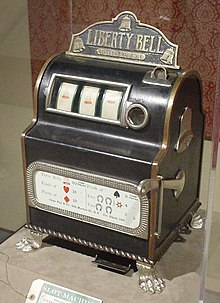Charles August Fey
Charles August Fey (born February 2, 1862 as Augustinus Josephus Fey in Vöhringen, Bavaria , † November 10, 1944 in San Francisco ) was an American inventor of German origin. He is known as the inventor of the so - called one -armed bandit (English slot machine) , the most famous mechanical slot machine in the world.
Life
Childhood and youth
Augustinus Josephus Fey was born in 1862 as the sixteenth child and youngest son of a poor family. At the age of 14 he visited his brother Edmund in Munich during his school holidays and found a job in a tool factory for a short time. There he discovered his talent and passion for mechanics early on.
Emigration and early years in the USA
In order to escape his patriarchal parental home and to avoid being drafted into the Bavarian military, Fey decided at the age of 15 to follow his uncle to the USA. However, he could not afford the expensive crossing to the USA , and so he first ended up in France and England . There he worked for a manufacturer of intercom systems and as a toolmaker for nautical instruments. After 5 years in London , he had finally saved enough money for the passage to America and sailed to New York . When he arrived in the New World, Fey initially lived with his uncle in New Jersey . When he emigrated back to Germany with his family, Fey decided to leave the east coast and travel to California . He arrived in San Francisco in 1885 and quickly found work as a mechanic. But only a short time later he became so seriously ill with tuberculosis that the doctors only gave him less than a year to live. Miraculously, however, he recovered from the illness and found a permanent position with the California Electric Works Company . He married Marie Christine Volkmar (1866–1942), with whom he had three daughters and a son. In 1889 he changed his name to "Charles August Fey".
Development of the slot machine
In his free time, Fey often tinkered with various machines in his workshop in order to research how they worked and improve them with his own ideas. When the passionate gambler once again had too little money for the casino one evening in 1887, the idea came to him in his workshop to build a gaming machine with 3 different reels that rotate automatically as soon as you pull a lever pays the profit. At that time there were already a number of mechanical slot machines, but they often had a complicated mechanism with 5 reels and symbols from poker . However, the large number of different winning combinations led to mechanically insoluble problems with the distribution of profits. Fey simplified the automatic mechanism by limiting his machine to 3 reels with 5 symbols each - horseshoes, diamonds, spades, hearts and a Liberty Bell - thus creating the first working automatic payout mechanism.
Fey called his machine "Liberty Bell", until later the name "Slot Machine" became established. It quickly became the most famous and popular slot machine in the United States, and so Charles Fey founded his own company in Berkeley in 1895 and continuously improved his invention. Fey did not sell his Liberty Bells, but rented them out to casinos and saloons on a 50/50 split of the profits. Since Fey could no longer satisfy the great demand himself, he teamed up with the Mills Novelty Company from Chicago in 1907 to form the company "Bell Machines". Fey later viewed this merger as a big mistake, but in 1910 the company brought out another pioneering machine with the so-called "Fruit Machine", in which the number of symbols was expanded to include fruits.
Retirement
Fey stayed with the company for many years, developing countless new and improved slot machines before retiring at the age of 82. Just 10 months later, he died of pneumonia .

Appreciation
Charles Fey was never able to make much profit from his invention during his lifetime, and he was denied due recognition until the end.
Forty years after his death in 1984, an official plaque was placed on a building north of Market Street in San Francisco for Charles Fey and his invention of the "Liberty Bell Slot Machine". The place is registered as "California State Historical Landmark No. 937". From 1897 until the great San Francisco earthquake of 1906, Fey's factory was located in the same place.
In 1989 his grandson Marshall Fey brought out an illustrated book on the history of Fey and the company, which appeared in several editions.
On October 10, 1997, the city fathers of Vöhringen placed a plaque on Fey's birthplace in his hometown, which today houses the city's youth center.
literature
- Marshall Fey: Slot Machines: A pictorial history of the first 100 years of the world's most popular coin-operated gaming device . Liberty Belle Books, Reno (Nevada) 1989, ISBN 978-0-962385-20-9 .
- Gerhard Reiter: Charles Fey. Inventor of the Liberty Bell Slot Machine . In: Geschichte im Landkreis Neu-Ulm , Landkreis Neu-Ulm , Series: Geschichte im Landkreis Neu-Ulm, 5th year 1999, ISBN 3-9804730-5-8 , pp. 131-138.
Individual evidence
- ^ California Historical Landmarks - San Francisco ( English ) California State Parks - Office of Historic Preservation. Retrieved February 4, 2013.
| personal data | |
|---|---|
| SURNAME | Fey, Charles August |
| ALTERNATIVE NAMES | Fey, Augustinus Josephus (maiden name) |
| BRIEF DESCRIPTION | German-American inventor |
| DATE OF BIRTH | February 2, 1862 |
| PLACE OF BIRTH | Voehringen (Iller) |
| DATE OF DEATH | November 10, 1944 |
| Place of death | San Francisco |

